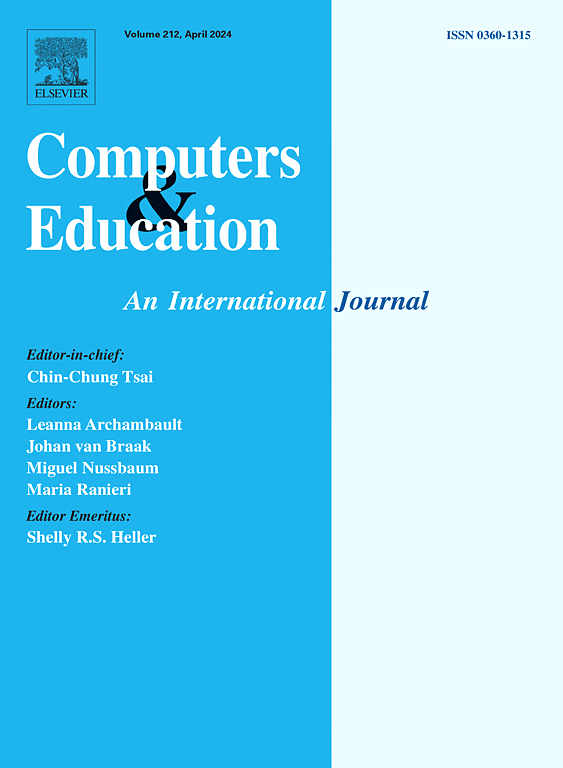Using multilayer network analysis to detect the collaborative knowledge construction characteristics among learner groups with low, medium, and high levels of cognitive engagement
IF 8.9
1区 教育学
Q1 COMPUTER SCIENCE, INTERDISCIPLINARY APPLICATIONS
引用次数: 0
Abstract
Collaborative knowledge construction (CKC) is advanced by group members' cognitive engagement across three levels: individual-level knowledge processing and proposing, the peer-level social interactions and knowledge exchanges between two group members, and the group-level coordination and construction of knowledge across multiple group members. The interconnected and transformative relationship among three levels is an essential factor during the CKC process. Individual viewpoints can trigger peer feedback, which can be further refined by other group members; the group-level consensus can provide foundations for subsequent individual- or peer-level cognitive engagement. The group-level coordination of knowledge advancement involves the processing, synthesis, and reflection of knowledge from multiple members to reach a group consensus. However, previous analytical approaches have faced challenges in modeling distinct types of interconnections across the individual, peer, and group levels during the CKC process. To address this gap, this research employed multilayer network analysis (MNA) to model and quantify the multi-level and interconnected characteristics of CKC in a series of face-to-face, computer-supported CKC activities in China's higher education. First, small groups were categorized into the high, medium, and low levels of cognitive engagement groups. Second, multilayer networks were constructed for each category, where students' use of cognitive strategies were set as nodes, the interconnections between cognitive strategies were set as edges, and three levels (i.e., individual, peer, and group levels) were set as layers. The node-, layer-, and network-level metrics were calculated to quantify the overall characteristics of the networks, the interconnected characteristics within a level and across the three levels. The MNA results revealed that, compared to lower level of cognitive engagement groups, groups with higher cognitive engagement demonstrated (1) more influential moderate and deep cognitive strategies at group and peer levels; (2) interconnections between cognitive strategies with higher diversity, connectivity, and more balanced distribution across three levels, but relatively lower information exchanging efficiency; and (3) communities with more interconnections related to the moderate and deep cognitive strategies at peer and group levels. Based on the empirical findings, this research proposed pedagogical implications for CKC practices and analytical implications for using MNA to improve the understanding of computer-supported collaborative learning mechanisms.
利用多层网络分析检测低、中、高认知参与度学习者群体的协作知识建构特征
协作式知识建构(CKC)是通过小组成员在三个层面上的认知参与来推进的:个人层面的知识处理和提出,两个小组成员之间同伴层面的社会互动和知识交流,以及多个小组成员之间小组层面的知识协调和建构。在 CKC 过程中,三个层面之间的相互联系和转化关系是一个重要因素。个人观点可以引发同伴反馈,而同伴反馈可以由其他小组成员进一步完善;小组层面的共识可以为随后的个人或同伴层面的认知参与提供基础。小组层面的知识进步协调包括对来自多个成员的知识进行处理、综合和反思,以达成小组共识。然而,以往的分析方法在建模 CKC 过程中个人、同伴和群体之间不同类型的相互联系方面面临挑战。为了弥补这一不足,本研究采用多层网络分析(MNA)方法,对中国高等教育中一系列面对面、计算机支持的CKC活动中CKC的多层次和相互联系的特点进行建模和量化。首先,将小组划分为认知参与度高、中、低三个等级。其次,为每个类别构建多层网络,将学生使用认知策略的情况设为节点,认知策略之间的相互联系设为边,三个层次(即个人、同伴和小组层次)设为层。通过计算节点、层和网络层面的指标,可以量化网络的整体特征、一个层级内和三个层级间的相互联系特征。MNA 结果显示,与认知参与度较低的群体相比,认知参与度较高的群体表现出:(1)在群体和同伴层面上,中度和深度认知策略的影响力更大;(2)认知策略之间的相互联系具有更高的多样性和连通性,在三个层面上的分布更加均衡,但信息交换效率相对较低;(3)在同伴和群体层面上,与中度和深度认知策略相关的社区具有更多的相互联系。基于实证研究结果,本研究提出了 CKC 实践的教学意义,以及使用 MNA 提高对计算机支持的协作学习机制的理解的分析意义。
本文章由计算机程序翻译,如有差异,请以英文原文为准。
求助全文
约1分钟内获得全文
求助全文
来源期刊

Computers & Education
工程技术-计算机:跨学科应用
CiteScore
27.10
自引率
5.80%
发文量
204
审稿时长
42 days
期刊介绍:
Computers & Education seeks to advance understanding of how digital technology can improve education by publishing high-quality research that expands both theory and practice. The journal welcomes research papers exploring the pedagogical applications of digital technology, with a focus broad enough to appeal to the wider education community.
 求助内容:
求助内容: 应助结果提醒方式:
应助结果提醒方式:


